Jane Ann Clark was born around 1842 at Strone, Newtownmore in Kingussie and Insch Parish, Inverness-shire. In 2010 my wife and I visited this area with her family. En route to the Wildlife Park we stopped off at Strone and took a few photos. There was no difficulty finding Strone Cottage, a modernised house still bearing 19th century (or earlier elements) but we do not know for sure if this is where the Clarks lived: there were other deserted houses close by and a track leading off into the hill behind presumably led to more houses.
From the OPR I have learned that her parents, Elizabeth Gordon (known as Betty) and John Clark of Banocher married in April 1827. He was a farmer. There were at least six children, born between 1831 and 1841. A Jane was born on 17th March 1836 but there is a consistent six year discrepancy from her marriage through all the census records up to her death certificate if this is the Jane Ann Clark who married Charles Douglas in 1866. It is possible that this Jane died young and our Jane Ann was indeed born around 1842, given her name but the registration of her birth has been lost or was simply not recorded. On the other hand the OPR is detailed in that we have the date of birth AND of baptism recorded for the children of the family. The gap between the two events varied between 2 weeks and almost 10 months. So if a child is not recorded on the OPR it seems odd. Their children were born at a place called Craigduaig or Croft Duaick or Croftuaich: it is hard to read the writing.
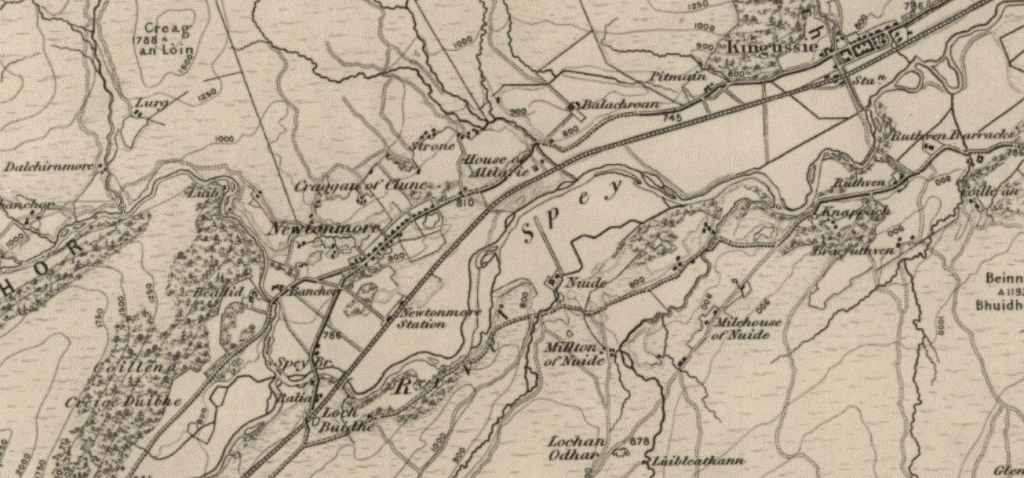
First edition, OS map, crown copyright. Note the presence of 5 houses at Strone, one of which I have photographed and labelled as an abandoned cottage. However, there is another cluster of 6 following the road east a short distance. One of these is Strone Cottage now. No name resembling Croftduaich is shown.
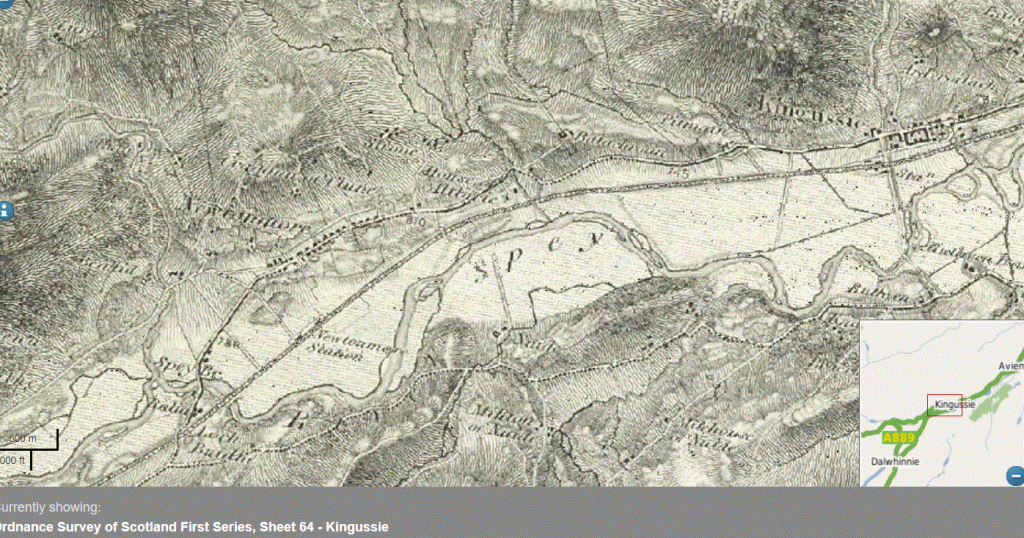
This OS map above adds no more to our knowledge. ScotlandsPlaces is an online resource to help identify places, compiled around 1875. Again, there is no sign of a Croftduaich.
However, our summer holiday 2022 saw us spend a week at what I regard as “home” and we stayed around Pitlochry. This included a visit to the Strone area and I bought a book called The New Townies of the Moor; Newtonmore-Advent and Advancement, 1820 to 1913 by Mary MacKenzie, Moyhill Publishing.
The author notes on P13 that many place names have been forgotten over time. A table on P27 listed lease holders of the early houses between Glen Road and the Laggan Road on the North side of Main Street. I mention this because she lists 16th and last small farmer Alexander Gordon, born at Newton of Clune and notes that he “Lived at Croftdhuac. Brother in law of Rob Warren who leased the feu in 1822.”
Croftdhuac sounds like the place we are searching for and the name Gordon features among Jane Ann Clark’s ancestors.
Family Tree of John Clark and Elizabeth Gordon:

On the 1841 census we see farmer John Clark, aged 50, (placing his birth around 1791) his wife Betty who is 35 (born around 1806) and children Isabel (12), Ann (9), Christy (5), Jane aged 3 or 5 (thus born around 1836 or 1838/9) and one year old Betty (Census 102/00 003/000).
The 1851 census has John (60), Betty (45) and children Isabella (22), Christian (13) and Betty (11) living at Strone. This is certainly the same family even if the ages are a little inconsistent. There is also a 7 year old son named John Clark now- though I have located the birth of John in 1841 so he should be 9 or 10. Missing are Ann and Jane.
However an Ann Clark aged 26 was an unmarried servant at Dell Farm Bothy, Kingussie and Insch. This age is a few years out to be the Ann born in Sept 1831 if accurate. This Ann lived with a 22 year old ploughman named Ewen McPherson and several other servants. One was a 17 year old coachman named William McPherson born in Kingussie.
Looking for Jane, a 15 year old Jane Clark, born at Kingussie, was a cattle herd at Lynachlaggan in Insh. Now if this is our Jane Ann Clark it points to her being some six years older than the age given on all late censuses, her marriage and death certificate. If it is the first born Jane then clearly she did not die as a young child with her name being re-used.
In 1861 no 6 Strone is described as a house of 2 rooms with windows. Farmer John Clark (74) had 3 acres. Living with him was wife Elizabeth (55), still unmarried daughter Isabella (30) and son John Duncan (a ploughman). His age of 17 is consistent with the 1851 census. Once again we have to ask if there were two Johns, one born in 1841 and another in 1844. There was also a two year old grand daughter named Christian Cameron.
I found 3 Jane Clarks of the right age roughly in Inverness-shire but none born in Kingussie and Insch. There were four in Perth city but I have not paid to view these yet.
Jane’s father died in January 1863 and his stated age suggests birth around 1797, although the census records suggest around 1791. John’s parents were Duncan Clark and Isabella Cameron according to the death certificate. I was able to find his death on the online index years ago and sent away for it. When it arrived it had been recorded with an ink pen so blotchy that I opened it, thought it said “Demoan Clark” and thought it was a waste of £15. Later I realised the correct name.
The just released Valuation Rolls for 1865 show Widow Isabella Clark or MacDonald (sic) occupied a house at north side, village of Newtonmore (VR 103/11/103). Apparently she was the proprietor. The value was under £4. In 1869 it was £3.

In 1871 a Christina Clark, granddaughter of Elizabeth Clark, is recorded. Her birth would be around 1860. I have a record of John D Clark, aged 35, born at Kingussie, living at Pitmain Cottage, Kingussie and Insch in 1881. He was unmarried. His age and name tie in roughly with the John D Clark who we noted above.
Jane’s sister Isabella died in 1874 at Alvie (SR 090/0B 0008). She was 46.
Jane Ann Clark’s Family:
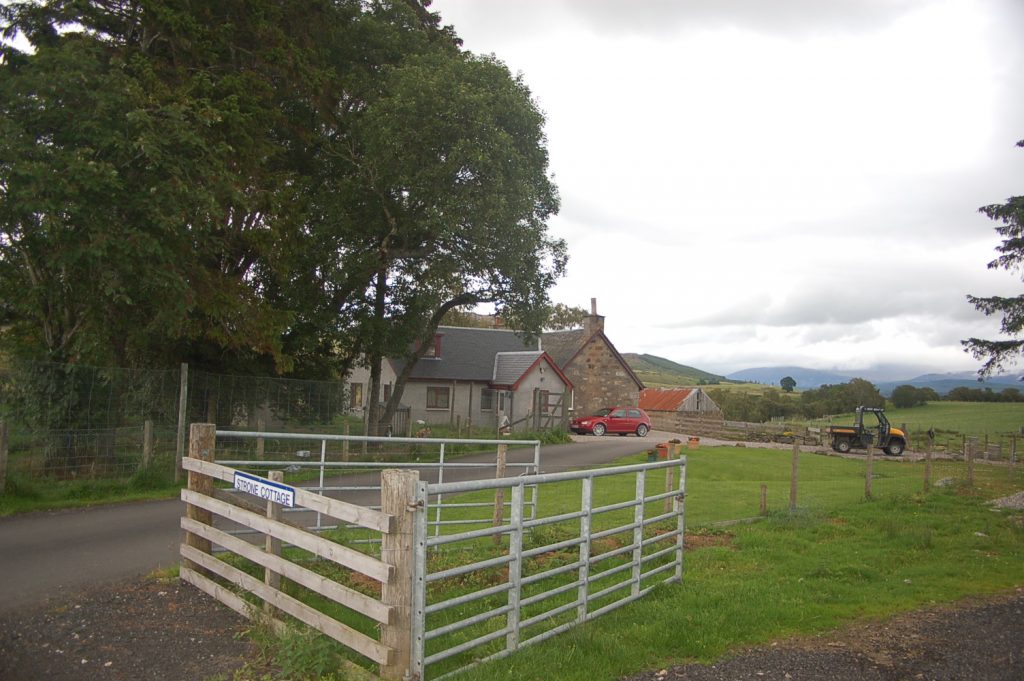
Strone Cottage, Newtonmore (author’s own)
Jane Ann Clark’s mother Elizabeth Gordon lived until October 1879. She had been born at Newton Moor in June 1805 (OPR 102/0020 0106). There is a little confusion as to Elizabeth’s mother- one source says Isabella McPherson (Elizabeth’s death certificate-SR 102/00) but another says Anne McPherson. The eldest child of John and Elizabeth was named Isabella but that could be after father’s mother. She died of gastro-enteritis. It could be that son John made a mistake and gave his paternal grandmother’s Christian name when reporting the death of Elizabeth Gordon.
Elizabeth Gordon’s father was a wool weaver called John Gordon. I have seen a suggestion on Ancestry that Elizabeth had a half sister and descendants living today but cannot verify any of this yet. I’m also aware that Ancestry can be dificult to rectify.
Generation VII: Family of John Clark and Elizabeth Gordon
1. Isabel Clark, c 1829 – 1874
2. Ann Clark, 1831- 1928
3. Duncan Clark, born 1834
4. Jane Clark, born 1836
5. Christian Clark, 1838 -1917
6. Elizabeth Clark, 1839- 1856
7. John Clark, born 1841
8. Jane Ann Clark, c1842- 1918
Elizabeth or Betty Clark died of inflammation of the brain in June 1856 and was buried at the Middle Burial Ground at Kingussie. Father John was able to sign the registration of her death.
August 2024. I can add that Jane Ann’s brother John seems to have been living at Pitmain Cottage on the 1881 census. He is described as a 35 year old general labourer.
Ann Clark apparently moved to Australia and married a fellow Scot named Alexander Fraser Munro. They had children and there are descendants there yet, according to a family tree on Ancestry. I have contacted the person who maintains the tree in the hope of finding confirmation and further detail. Certainly there is a DNA connection as my father, Charlie Douglas, held 30 cM in common with one descendant.
Christian or Christina Clark also moved to Australia, though whether they went together or at different times I do not know. She married an Andrew Collie in 1863 and died in 1917. Andrew was apparently from Rothiemurchus so they may have known each other prior to emigrating. I have sketched out a tree of her descendants and am aware that my father has DNA in common with two whilst I have shared DNA with one of them.
Gaelic or English?
We know that Jane Ann Clark spoke Gaelic and English. As her family came from the Highlands it is likely that her parents and siblings also spoke Gaelic. What I cannot be clear in is whether this was the first language of the people of Newtonmore or whether by the 1840s it was a residual language, taking second place to English. Someday I hope to visit the Highland Folk Museum there to find out more.
Jane Ann Clark’s daughter and her Family
Jane Ann Clark’s illegitimate daughter Georgina MacBean was brought up by her natural father, William MacBean. She spoke Gaelic and English according to a census answer.
Georgina was born on 9th July 1861 at Strone. Jane was probably around 19 at the time. Her early life is still sketchy to me. The 1881 census shows her as one of 6 servants working for a farmer at Bridge of Tilt. Her birthplace is shown as Newtonmore.
Locating information on Georgina and her family was very difficult and I do not regard the work as complete. Eventually I located James McLean and wife Georgina on the 1891 census at Rothiemurchus in Inverness-shire. He was 35, she 29. He was a farm servant and had been born in Dutrich, Inverness-shire. She was born in Kingussie. They lived in a 2 room house.
The 1901 census showed James was a farmer at Ballenreach Farmhouse, Ardclach, Nairnshire. He and Georgina had 7 children. These were Isabella MacPherson MacLean (being her maternal great grandmother’s name), Elizabeth who was 9, William 8, James 6, Jessie 5, Alexander Duncan aged 4 and Donald who was 2. The two eldest children had been born at at Rothiemurchus, William at Duthil, Inverness-shire, the next 3 at Alvie and Donald at Ardclach so they must have moved to that farm between 1896 and 1899.
Georgina had married James MacLean on 27th March 1891 at Dunachton, Alvie in Inverness-shire (SR 090/B0 0002). He described himself as a farm manager. Georgina said her father was dead and identified Jane Douglas ms Clark as her mother. A Donald MacLean witnessed the wedding. She died at Spey View, Advie, Morayshire on the first of November 1952 (SR 128-01 5). A MacLean of 5 South Street, Grantown on Spey registered the death. This is likely to be a child or grandchild.
The Valuation Rolls show (VR 110/7/469) that James was a tenant occupier of the farm of Balinreach, Estate of Glenferness in 1905. It was owned by the Right Honourable Earl of Leven and Melville. He was paying £47-1-3 a year in rent.
The 1911 census shows the couple living at Newton of Belivat in a house where 3 rooms had windows. James and Georgina both spoke Gaelic and English. They had been married 21 years and had now had 10 children, all of whom were still alive. At home still were James, Alexander and Donald. The children born since the last census were Robert, 9, George, 6 and Jane A who was four. Presumably she was named after her grandmother (Census 120/00 005/00 001).
The 1915 valuation rolls show a James MacLean, shepherd, as inhabitant of house 33, on the estate of Lethen and Coulmony. Six owners are cited for the estate. Rent was £4-10. I wonder if this is son James rather than father.

The MacLeans on the 1921 census.

Above: the grave of Jane Ann Clark’s daughter Georgina and her family. Note that it shows a grandson named Robert but I do not know whose child this was yet. Son Ronald McLean is said to have moved to Hawata, New Zealand and to have died there on 19th April 1956. I have found a wedding for him with Flora MacLeod but do not know if they had children yet.
I have found nothing about the eldest child, Isabella MacPherson MacLean but the second, Elizabeth Isabella MacLean married a William Dewar at the Palace Hotel in High St, Grantown on Spey on 3rd June 1930. Given the year, any children’s births cannot be accessed currently. Elizabeth was a domestic servant at the time. William Dewar’s address was Invercauld, Braemar. He was a gamekeeper, presumably at an estate there.
William MacLean married a parlourmaid named Mary Paterson on 17th November 1931 at the Castle in Inverness. William was a gamekeeper. His address is hard to read: MacLeach Lodge or Loag is written but also Balnain Lodge, Grantown on Spey.
Jessie MacLean died on 25th May 1923. Her death certificate was registered by her brother Alexander. It states that she was a nurse and had suffered from TB. There is a parallel here with Jane Ann Clark’s brother in law, whose daughter was a nurse and died young of TB.
Alexander Duncan MacLean joined the army a month before war was declared at Nairn. He had no job at the time of the 1911 census so this may have given him a big opportunity. Alexander served in the Lovat Scouts as a private. The Lovat Scouts was a Territorial Army unit and was intended to be composed of men like game keepers who could scout, snipe and withdraw. His service number was 26504. A biography available on Ancestry says that he served in Salonika and France and was injured twice. His occupation was said to be an estate worker.
The Long, Long Trail website suggests that his unit would have been assigned to the 82nd Brigade and landed at Salonika on 20th October 1916. That is, if I am correct that he was in the 1/1st Lovat’s Scouts Yeomanry which had been formed after the Boer War.
In August 1914 this regiment had moved to Blairgowrie, then Huntingdon, then to Northamptonshire. They did not go into action until late in 1915 after arriving at Alexandria in Egypt on 18th September. In December 1915 they left the front and returned to Egypt. In Feb 1916 they were in something called the Western Frontier Force. After reorganisation they landed at Salonika as part of 82nd Brigade in the 27th Division. In June 1918 they left this brigade and moved to France. At that time the Western Allies were under immense pressure as a result of the German’s Spring Offensive which had very nearly won them the war. The regiment became Line of Communication troops.
Alexander died on 5th April 1970 and was buried at Grantown On Spey. With him is his wife, Annie Cruickshank. She died on 26th April 1994 at the age of 85. According to their wedding certificate, her family were from Wester Achnagallon, Cromdale where they married on 29th July 1927. His brother James was a witness. William was a road contractor at the time.
His younger brother Donald also joined up as soon as he was old enough. Donald was a gunner in the Royal Field Artillery. His number was 278616. When he joined up on 29th May 1918 he was described as a farm servant. The last 10 days of May 1918 were the blackest for the Western Allies, with the German’s last offfensive almost breaking through the line. Casualties were very high indeed.
However, given the training period for recruits Donald might not actually have served in action. Unfortunately, their service records seem to have been casualties of the Luftwaffe in WW2.
Turning to the next page on Anestry’s digital copy of Scotland’s Roll of Honour 1914-1918 I realised that their elder brother James had been a peace-time volunteer for the army, enlisting in April 1911. He served in the Lovat Scouts and was present at the Dardanelles. As with his two brothers, his service papers do not seem to have survived WW2.

Generation VIII: Family of James MacLean and Georgina MacBean
Isabella McPherson MacLean, b1886 Rothiemurchus
Elizabeth Isabella MacLean, born 9th August 1891 Inverdruie, Inverness-shire
William MacLean, born 1893 Duthil, Inverness-shire
James MacLean, born 1895 Alvie
Jessie MacLean, 1896- 25th May 1923
Alexander Duncan MacLean, born 1897 Alvie
Donald MacLean, born 1899 Ardclach, Inverness-shire
Donald Thompson MacLean, 6th September 1901 – 19th April 1956
George MacLean, born 1905 Ardclach, Nairn
Jane Ann MacLean, born 1907 Ardclach, Nairn
In August 2024 I came across this article in the Aberdeen Advertiser which refers to a Georgina’s death and her son’s role in organising an event. This was in 1968 so cannot be the above Georgina Maclean nee MacBean but it might be another relative.

A Famous McPherson
My notes from a brief incursion into the OPR for Kingussie and Insch in May 2006 also recorded that there were three McPherson families at Strone. I did not have time for in-depth research at that point. There is a possible link to a well-known soldier.
In 2014 Sir Tommy McPherson died. He was a highly decorated British soldier from WW2, with three Military Crosses, three Croix de guerre and a Legion d’honneur. According to his autobiography Sir Tommy was from Strone. He relates that of his family of seven, some were born in India (where his father was a judge), he in Edinburgh and others at Strone. Sir Tommy’s grandfather was the minister who christened him. Sir Tommy’s siblings had been born before WW1 and the implication is that he was born around 1919 or 1920. He relates how his other grandfather, the McPherson one, was born at Strone and inherited a croft there. He married an Anne Stewart. From Scotlands People I know this was in 1875. As well as the judge there were two other brothers- the youngest served with the Queen’s On Cameron Highlanders in WW1 and the other was a government minister (p12-13). This latter would be Mr James Ian McPherson, under-secretary for War in 1917. He became 1st Baron Strathcarron. He was Chief Secretary for Ireland from January 1919 until April 1920, at a very challenging time with the rise of extremist violence in a deeply divided country.
Further reading:
Behind Enemy Lines, Sir Tommy McPherson with Richard Bath, Mainstream Publishing, Edinburgh and Lothian, 2010

Abandoned cottage at Strone, Newtonmore (author’s own)
Looking at the 1841 census at Strone there was a 55 year old tailor called Alexander McPherson and his 50 year old wife Ann. Living with them were (I presume) a 20 year old daughter, Janet, and what may be Janet’s one year old son John McPherson. Also present was Ann Shaw aged 10.
At another house in Strone lived 10 year old John McPherson as an agricultural labourer, with the Cattanach family.
Another house was led by 70 year old John McPherson (ag lab) and his 50 year old wife Ann with a 10 year old Ann and unreadable or just “not known” VK or NK aged 2.
Also at Strone was 60 year old Margaret McPherson, 35 year old Janet, 20 year old Ewan (ag lab), a William… aged 5 and what looks like Nily McPherson aged 10. Once again we also have NK aged 2.
Another house at Strone led by John Kennedy included a ten year old ag lab named Alexander McPherson, two year old John McPherson and a Margaret Gordon aged 35.
All this is enough to tell us that this was a close-knit community and establishing exactly who was related to whom and how will not be straightforward.
In 1851 the Strone community included a farmer of 3 acres named Alexander Gordon who was born in Kingussie, his Laggan-born wife Janet and daughters Grace (8) and Katherine (6) and May (1) as well as a servant.
Isabella Clark or MacDonald id shown on the Valuation Rolls for 1861, 1865, 1873 and 1874. The 1885 record does not show her.
There is also a reference to poor relief of 3 shillings to Widow Clark or MacDonald.
The Kirk Sessions refer to the widow of a former minister, Mrs Anderson, leaving a generous bequest to the parish upon her death. This was discussed in 1847 at the January Kirk Session. The commentary makes clear that the community was suffering badly due to the harshness of the last winter and the potato famine causing crop failure.
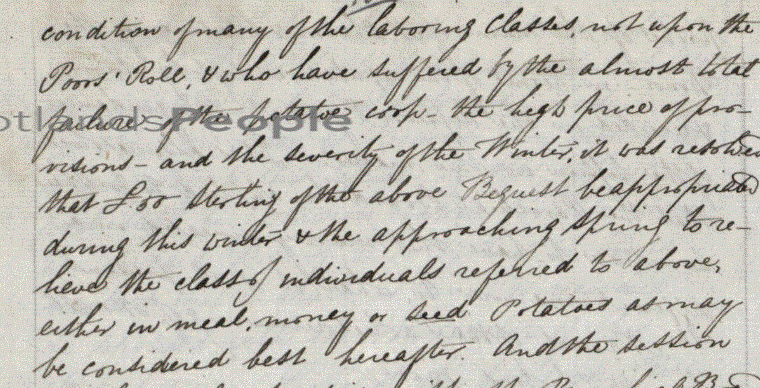
Across the river lies Ruthven, complete with the ruins of an army barracks built in the 18th century atop a hillock reminscent of a large Norman motte. This is probably what it was as the Comyn lords of Badenoch had a castle here in the 13th century. It was also the base of the infamous Wolf of Badenoch later, Alexander Stewart. He lies today at Dunkeld Cathedral close to the tomb of the [now] unquestionable grandson of Bonnie Prince Charlie, whose soldiers burned the barracks in 1746. For, this was the scene of combat during the 1745-6 Jacobite Rising as Jacobite soldiers fought to overcome the pro-Hanoverian garrison.
The Jacobites generally had a poor success rate against any sort of fortification but this was actually a success in the end. In August 1745, at the start of the Rising, Sergeant Terry Molloy of the 6th Regiment of Foot commanded 12 men who held off 200 Jacobites. Before Culloden the now Lieutenant Molloy surrendered the barracks to Jacobites led by Gordon of Glenbucket as he had two cannon with him.
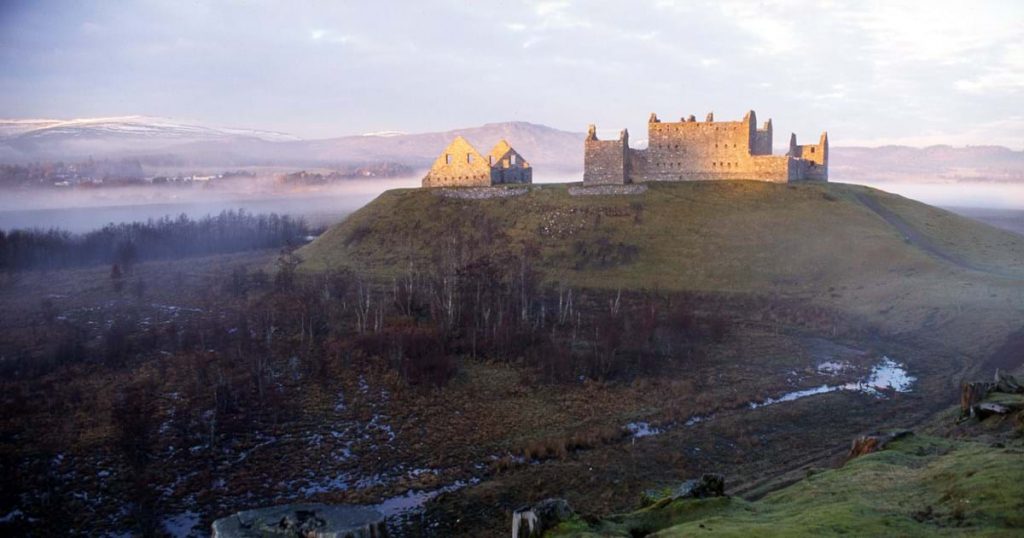
Photo of Ruthven Barracks, copyright historicenvironment.scot
This was a Pyrrhic Victory, we now know, but Ruthven was the place Bonnie Prince Charlie designated for his army to rally in the event of defeat at Culloden. Here, indeed, a force of Jacobite soldiers did gather, possibly up to 3000 strong. They dispersed when the prince sent word to do so. Charlie had not lost hope altogether but he knew that the cause was in deep difficulty at this time and instructed every man to look for himself. He thought that if he could get to France he would be able to bring back an army to restart the campaign. This proved not to be.
We lack information on the Clarks, Gordons and MacPhersons in terms of how long they had been living in the Strone area but it seems likely that they would have known people whose parents could recall events of the Rising.
Going back further in time, had Robert Bruce not murdered John Comyn in Dumfries or had Edward Balliol retained his supremacy in the 1330s, the “geopolitical” situation might have led to Badenoch (and the whole of the Highlands) being richer and more influential than was the case by the 19th century.